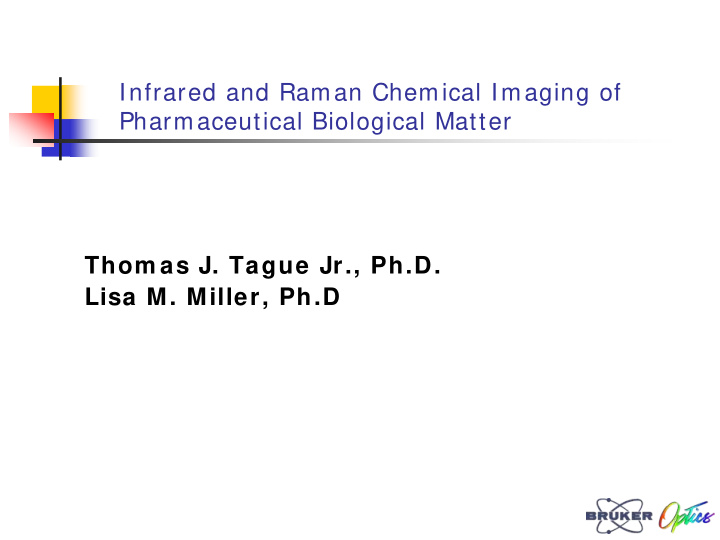



Infrared and Raman Chemical Imaging of Pharmaceutical Biological Matter Thom as J. Tague Jr., Ph.D. Lisa M. Miller, Ph.D
Bone disease Osteoporosis affects (WHO report) � ~ 1 in 4 women over the age of 50 � ~ 1 in 8 men over 50 � Treatment regimens are primarily effective at slowing � bone mass loss Regimens to increase bone mass are desired � Change bone health focus from a minimization of risk to � increase in health Remodeling would need to be monitored �
Bone assessment Hip and spine measurements of bone density using � DEXA is the “gold standard” Ultrasound (measure of bone mass) can be � complementary in assessing bone Not suitable for drug therapy monitoring � � Not sensitive enough to detect changes in bone less frequently than every year Bone microstructure not evaluated � � A leading cause of spinal fracture (highly debilitating)
Current methods of assessment of regimen effectiveness “Treat and hope” � � Administer direct or indirect drug to suppress osteoclast production (ex. hormone replacement) � Monitor every year “Post mortem” � � Administer therapy and assess after necropsy � Rat � Monkey
Potential use of spectroscopy Visual observation can be used to observe � microstructure Bone mineral content is indicative of bone health � Chemical analysis of important molecular species � without staining � Infrared active � Raman active Imaging of tissue is possible with excellent spatial � resolution
Hyperion 3000 Microscope
Components of microanalysis system Optical microscopy � � Brightfield, darkfield, polarization, and fluorescence illumination Infrared microscopy � � MCT single element, FPA detectors � Rapid-scan modes of acquisition Data archival � � GLP and 21CFR-11 validated software � All data (including video images) saved with file
Components of microanalysis system Data manipulation � Global peak height, integrations, other calculations � Global chemometrics (includes factor analysis), functional � group profiling Images copied to clipboard, numerical cut and paste into � Excel
Study Protocol Monkey Tibia Examined after Necropsy � Newly modeled bone detected using fluorescence � markers
Collection parameters Midband MCT detector � 128x128 MCT Focal plane array detector � Software selection of all hardware � 4 wavenumbers resolution � 15x objective (2.7 microns/ pixel) ~ 166 micron analysis area � Macromeasurements up to 6 mm �
Data results � Infrared band of interest (carbonate) requires good s/ n (> 100: 1) � 3 seconds rapid-scan acquisition for 4 cm -1 , 16384 spectra
Brightfield image of bone tibia
Crossed polarization image
Assembled image of bone tibia (15x) Flatfield correction For uneven illumination not applied
Bone tibia under green illumination, 15x objective
Bone tibia with green illumination Fluorescent marker indicating bone modeled during therapy
Bone tibia with UV illumination Green - Bone modeled with calcein marker, administered one year after ovariectomy Yellow – Bone modeled with alizarin complexone, two years after ovariectomy
Visible image of bone tibia with corresponding global infrared chemical image
Infrared spectra of bone tibia Bone modeled after 2 years 1.5 1.0 0.5 0.0 Absorbance Newly modeled after 1 year 1.5 1.0 0.5 0.0 1.5 Cartilage portion of tibia 1.0 0.5 0.0 3000 2000 1000 Wavenumbers (cm -1 )
Infrared band assignments 900-1200: phosphate � 1415: carbonate � � 850-880: too low to see 1375-1450: lipids (-CH 2 ) � 1660: amide I � 1550: amide II � Calcein and alizarin complexone bands not evident �
-2 Chemical profile of CO 3 Integrated intensity of 1415 cm -1 band y-axis profile at x-axis = 10 µm
Bone image of carbonate intensity
Carbonate intensity (mineralization)
Protein content
Carbohydrate and lipid content
Absorbance Units 0.00 0.05 0.10 0.15 0.20 0.25 Typical spectrum of Osteoblast Cell 3288 3 0 00 2923 2853 2 50 0 W a ve nu m ber c m -1 20 0 0 1736 1664 1547 1 5 0 0 1448 1235 1099 1 0 00 965
Osteoblast Cell Chemical Imaging with Video Imaging C-H Integration area: 3200-2800 cm -1
Osteoblast Cell Chemical Imaging with Video Imaging C-N Integration Area: 1700-1500 cm -1 (Protein)
Osteoblast Cell Chemical Imaging C-H and C-N Chemical Imaging
Images of 1736 (lipid) and 1664 (Amide I) Peaks
Images of 1547 (Amide II) and 1448 Peaks
Conclusions High quality acquisition of IR-images within minutes 1. Large sample areas can be analyzed simultaneously 2. OPUS imaging software is friendly and powerful 3. FTIR-imaging is already a well established technique. 4. FT-IR Microscopy FPA imaging is very powerful tool to 5. analyze biochemistry samples.
Images of 1547 (Amide II) and 1448 Peaks
Conclusions High quality acquisition of IR-images within minutes 1. Large sample areas can be analyzed simultaneously 2. OPUS imaging software is friendly and powerful 3. FTIR-imaging is already a well established technique. 4. FT-IR Microscopy FPA imaging is very powerful tool to 5. analyze biochemistry samples.
Raman Imaging - Experimental Parameters 532nm excitation � 50 micron pinhole at spectrometer entrance (confocal � mode) 3 cm -1 resolution � Single coaddition � 1 or 2 seconds integration �
Typical Raman Spectrum of Tylenol Integration area: C-H 3126-2811cm -1 532nm Laser, 20mW, 1s scan C= C 1705-1482 cm -1 0.5um mapping step
Raman Imaging of Tylenol Tablet Integration area: C-H 3126-2811cm -1 C= C 1705-1482 cm -1
Typical Spectrum of Polystyrene 1000 2 seconds integration 800 600 Raman Intensity 400 200 0 4500 4000 3500 3000 2500 2000 1500 1000 500 Wavenumber cm-1
Polystyrene Single Ball Raman Imaging 532nm Laser, 5mW, 2s scan time, 0.5 um mapping step, Integration area: 3179-2765cm -1
Sample SWNT Array
Sample SWNT Array, map of square Integration of 1575 cm -1 band
Smaller grid area of vertical array V-UNT
Line array section of vertical array sample Note: Limit of optical microscopy is reached.
Summary � Raman AND IR imaging are now capable of generating more than just “pretty pictures”
Recommend
More recommend